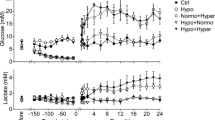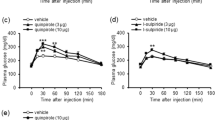Summary
Unilateral 6-hydroxydopamine lesion of the mesostriatal dopaminergic system was found to ameliorate neuronal necrosis in the caudate-putamen following 30 min of insulin-induced hypoglycemic coma. We propose that increased release of dopamine in the striatum during hypoglycemia or in the recovery period potentiates a deleterious neuronal hyperexcitation, probably induced by excessive release of glutamate or related compounds, thereby aggravating neuronal necrosis.
Similar content being viewed by others
References
Agardh C-D, Carlsson A, Lindqvist M, Siesjö BK (1979) The effect of pronounced hypoglycemia on monoamine metabolism in rat brain. Diabetes 28: 804–809
Auer RN, Olsson Y, Siesjö BK (1984a) Hypoglycemic brain injury in the rat. Correlation of density of brain damage with the EEG isoelectric time: a quantitative study. Diabetes 33: 1090–1098
Auer RN, Wieloch T, Olsson Y, Siesjö BK (1984b) The distribution of hypoglycemic brain damage. Acta Neuropathol (Berl) 64: 177–191
Bishop GA, Chang HT, Kitai ST (1982) Morphological and physiological properties of neostriatum neurons: an intracellular horseradish peroxidase study in the rat. Neuroscience 7: 179–191
Björklund A, Lindvall O (1986) Catecholamine-containing brain stem regulatory systems. In: Bloom FE (ed) Handbook of physiology, Vol 4. Integrative systems. Williams and Wilkins, Baltimore (in press)
Blomqvist P, Lindvall O, Wieloch T (1985) Lesions of the locus coeruleus system aggravate ischemic damage in the rat brain. Neurosci Lett 58: 353–358
Bouyer JJ, Park DH, Joh TH, Pickel VM (1984) Chemical and structural analysis of the relation between cortical inputs and tyrosine hydroxylase-containing terminals in rat neostriatum. Brain Res 302: 267–275
Dray A (1980) The physiology and pharmacology of mammalian basal ganglia. Prog Neurobiol 14: 221–335
Freund TF, Powell JF, Smith AD (1984) Tyrosine hydroxylase-immunoreactive boutons in synaptic contact with identified striatonigral neurons, with particular reference to dendritic spines. Neuroscience 13: 1189–1215
Groves PM (1983) A theory of the functional organization of the neostriatum and the neostriatal control of voluntary movement. Brain Res Rev 5: 109–132
Hirata K, Yim CY, Mogenson GJ (1984) Excitatory input from sensory motor cortex to neostriatum and its modification by conditioning stimulation of the substantia nigra. Brain Res 321: 1–8
Kalimo H, Auer RN, Siesjö BK (1985) The temporal evolution of hypoglycemic brain damage. III. Light and electron microscopic findings in the rat caudoputamen. Acta Neuropathol (Berl) 67: 37–50
Kitai ST (1981) Electrophysiology of the corpus striatum and brain stem integrating systems. In: Brooks V (ed) Handbook of physiology, nervous system Vol 2, Motor control, Chap 20. Williams and Wilkins, Baltimore, pp 997–1015
Lorén I, Björklund A, Falck B, Lindvall O (1980) The aluminum-formaldehyde (ALFA) method for improved visualization of catecholamines and indoleamines. I. A detailed account of the methodology for central nervous tissue, using paraffin, cryostat or vibratome sections. J Neurosci Meth 2: 277–300
Nevander G, Ingvar M, Lindvall O (1986) Mechanisms of epileptic brain damage: evidence for a protective role of the nor-adrenergic locus coeruleus system in the rat. Exp Brain Res 63: 439–442
Park MR, Lighthall JW, Kitai ST (1980) Recurrent inhibition in the rat neostriatum. Brain Res 194: 359–369
Somogyi P, Bolam JP, Smith AD (1981) Monosynaptic cortical input and local axon collaterals of identified striatonigral neurons. A light and electron microscopic study using the Golgi-peroxidase transport-degeneration procedure. J Comp Neurol 195: 567–584
Ungerstedt U, Arbuthnott GW (1970) Quantitative recording of rotation behaviour in rats after 6-hydroxydopamine lesions of the nigrostriatal system. Brain Res 24: 485–493
Wieloch T (1985) Hypoglycemia-induced neuronal damage is prevented by a N-methyl-d-aspartate antagonist. Science 230: 681–683
Wieloch T, Engelsen B, Westerberg E, Auer R (1985) Lesions of the glutamatergic cortico-striatal projections in the rat ameliorate hypoglycemic brain damage in the striatum. Neurosci Lett 58: 25–30
Wieloch T, Lindvall O, Blomqvist P, Gage FH (1985) Evidence for amelioration of ischaemic neuronal damage in the hippocampal formation by lesions of the perforant path. Neurol Res 7: 24–26
Zetterström T, Herrera-Marschitz M, Ungerstedt U (1986) Simultaneous measurement of dopamine release and rotational behaviour in 6-hydroxydopamine denervated rats using intracerebral dialysis. Brain Res (in press)
Author information
Authors and Affiliations
Rights and permissions
About this article
Cite this article
Lindvall, O., Auer, R.N. & Siesjö, B.K. Selective lesions of mesostriatal dopamine neurons ameliorate hypoglycemic damage in the caudate-putamen. Exp Brain Res 63, 382–386 (1986). https://doi.org/10.1007/BF00236856
Received:
Accepted:
Issue Date:
DOI: https://doi.org/10.1007/BF00236856




